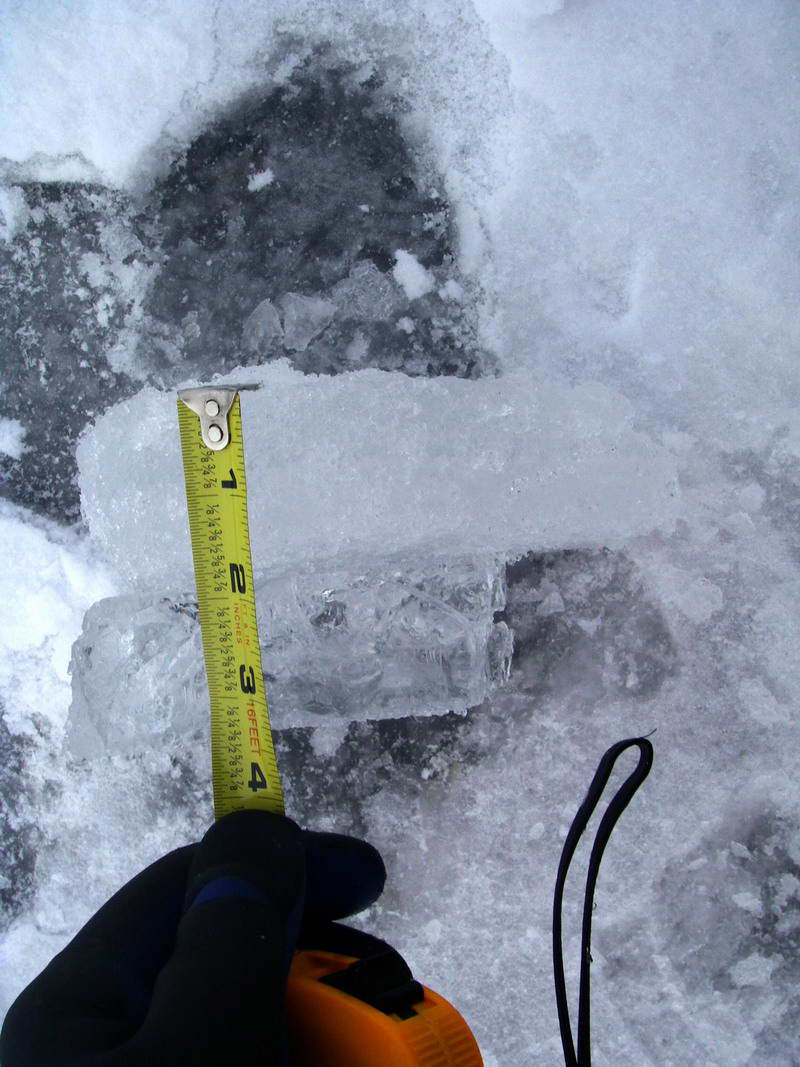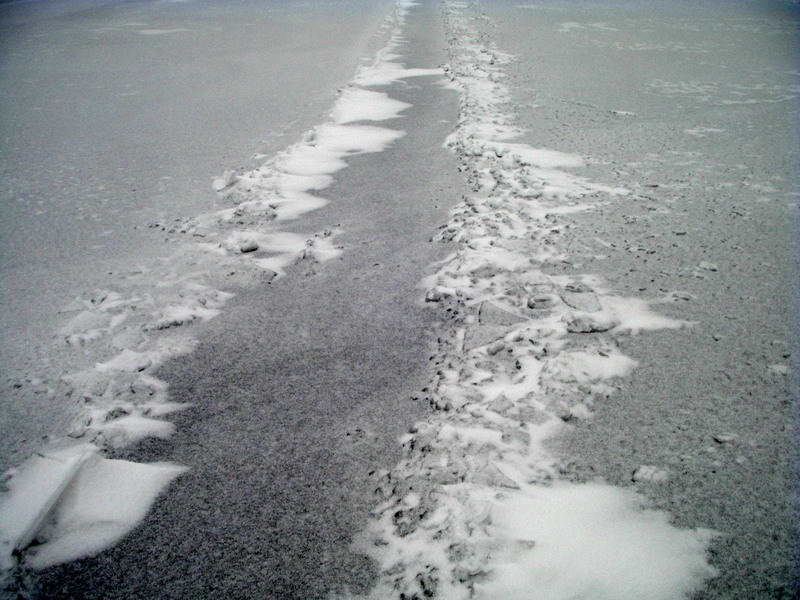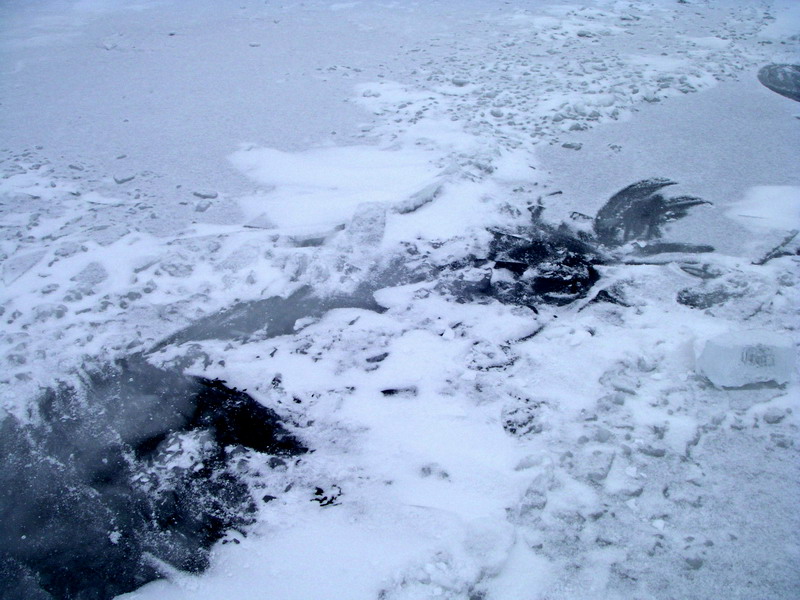Tragedy on Lake Dunmore - Salisbury VT, Jan 9, 2010
By Bob Dill
On a cold, sunny January 9th, three generations of the Flynn family were out for a day of snowmobiling on three sleds. They stopped at the edge of Lake Dunmore near the fishing access on the west side of the lake. The ice had been in for 10 days, and at the edge of the lake it was a solid six inches thick. Several sled tracks fanned out from the entrance point. It looked a lot like typical mid-winter ice.
What was not apparent was that by roughly 150 feet from shore the ice was a layer cake with 1.4 to 2" of black ice under 0 to 3" of slush with a frozen slush crust that gave a total thickness of 5". There was thin snow (up to an inch) covering about 30% of the ice the day after the accident. The only reason the sleds that left those tracks did not fall through was they were going fast. At the more modest speeds the Flynns were going, the ice was not strong enough. All three sleds broke through. Heroic actions by the riders, neighbors and rescue personal saved three lives. Three more perished.
John McCright's article in the Addison County Independent is a complete account of the accident and its aftermath. It is no longer available on their website.
 A sawed-out piece of the 5" layer cake: 2" frozen slush, 1.5" of slush (missing) and 1.4" of water ice (black ice) on the bottom.
A sawed-out piece of the 5" layer cake: 2" frozen slush, 1.5" of slush (missing) and 1.4" of water ice (black ice) on the bottom.
I visited the scene the day after the accident to examine the ice. The ice on most of the north end of Lake Dunmore had frozen in a cold spell a few days before the New Year's weekend storm that deposited about about 14" of fluffy snow. The ice grew to between 1.4"and 2” before warmer temperatures and the New Year's snow stopped further growth. As the snow accumulated it got heavy enough to submerge the thin ice sheet, allowing water to come up through cracks. This locally saturated the snow pack, making it much heavier which created more cracks and more slush until the entire new ice sheet was covered with about three inches of slush. The top layers of the snow pack may not have become saturated, leaving an insulating snow layer. The slush began freezing from the top. Later in the week, small amounts of snow fell, which further inhibited the slush from freezing. The water ice layer could not grow thicker until the slush layer froze completely. For most of the ice sheet, this took place two to four days after the accident.
The total thickness away from shore was 5”. In some areas, especially near shore, the slush had frozen through to the black ice layer by Sunday. Thin snow drifts probably played a role in which areas refroze all the slush and which did not. From a distance, all the ice looked like typical mid-winter grey ice with occasional thin snow cover. Click here for a weather time line with a best guess about how the ice evolved.
The breakthrough thickness for a stationary, 180-lb person standing on cold black ice is about 1.2 inches. Based on this, a 700 lb snow machine and rider on black ice near 32 degrees has a low speed breakthrough thickness of a little under 3" (5" of cold black ice is the minimum recommended thickness). The breakthrough thickness for a moving snow machine is lower and not well understood by me. Snow ice (refrozen slush) can be weaker or stronger than black ice depending on how completely frozen it is. The slush and water layer have add minimal strength to the layered ice. The ice sheet on Saturday was only as strong as its strongest layer. On most of the north end of the lake, that was the 1.4" to 2” black ice layer.
 Close-up of one of the fast sled tracks. The track is lined with broken crust and splashed-out slush.
Close-up of one of the fast sled tracks. The track is lined with broken crust and splashed-out slush.
There were several snowmobile tracks fanning out from the fishing access. From a distance it was easy to see why they gave confidence to the Flynns, but seeing them up close told a different story. All of them had broken through the snow ice crust: some for the entire track and some just most of the time. I found a few feet along one track where the bottom layer broke out as well. One of the Charlotte VT Fire and Rescue guys tracked down the rider who made this track. He felt his machine breaking through and got on the throttle to get back ontop of the black ice layer.
 A section of track from one of the fast sleds that broke through the crust and bottom layer! The dark areas have no bottom ice layer.
A section of track from one of the fast sleds that broke through the crust and bottom layer! The dark areas have no bottom ice layer.
Terry Flynn was the third sled on the ice and the first to break through. As she saw what was happening she pushed her four-year-old passenger off her sled . This may have prevented the accident from being a six person fatality. A few days before the accident she read in the VAST (Vermont Association of Snow Travelers) newsletter about putting your wet coat sleeves on the edge of the ice and letting them freeze to the ice. In the 10 degree weather this worked and this allowed her to get herself out. Ice claws would be more effective, particularly if the temperature had been warmer.
I had a conversation with Mickey Bartlett, the neighbor across the street who was the first to respond. He, an Addison County deputy sheriff (Oscar Gardner) and volunteer fireman (Foster Provencher) decided to go onto the ice before cold water rescue equipment arrived. They saved one life and almost saved a second. Should they have gone out? Given that more rescue people were on the way, I think they made the right call. It was not an easy one in any case. What these men did was heroic.
Further thoughts:
Ice claws are the one simple and inexpensive thing that would dramatically reduce the number of ‘through the ice’ fatalities. They can be found in local stores that sell ice fishing equipment and they are also easy to make. The only people who almost always carry them are ice sailors and nordic skaters. People driving any machine on the ice are at particularly high risk for going through and they almost never have ice claws.
 Different types of ice claws.Life jackets or flotation clothing probably would have saved everyone as well.
Different types of ice claws.Life jackets or flotation clothing probably would have saved everyone as well.
It might be tempting to say that going fast on a sled is better than going slow. In this case, that may have been true. On the other hand a fast sled can carry you far out onto ice that will not support you even on foot. If you broke through for any reason, even ice claws and protective clothing may not be enough to save you. I expect experts can point to many other situations where less speed is safer. Going slow is clearly less risky with wheeled vehicles that have no ability to plane across open water.
Should the authorities test the ice and close access if the ice is not safe? This would be an impossible job for several reasons. The integrity of ice is different in different places. There is no reasonable way to verify that there is no weak ice anywhere. Ice that is OK for a snow machine may not be be sufficient for a pickup truck. In addition ice conditions can change very rapidly. In the Spring thaw, even a couple hours can change ice from OK to treacherous. In my opinion it has to be up to all people going onto ice to make their own assessment of conditions and their willingness to accept the inherent risks. A notice about the general risks of ice travel and a recommendation to carry ice claws and wear life jackets could posted at popular ice entrance points. Incorporating information on the value of ice claws and personal flotation (flotation suits, float coats or life jackets) into snowmobile safety classes would get riders to think about ice differently.
What the Flynns saw when they stopped to look at the ice at the edge of the lake would have looked reasonable to many experienced ice travelers. Should people test the ice more? This accident clearly says we all need to be more careful in making ice assessments, especially when vehicles are involved. When on foot, you are lighter, moving more slowly and are more sensitive to what the ice is telling you. If you have a test pole, ice chisel or drill it is also easy to test the ice as you go along. With a vehicle, you can’t realistically test the ice while you are moving. Sending a person or two out on foot for a fair distance off shore might have saved the day in this case. Doing this requires a test tool for assessing the ice thickness and ice claws at a minimum. A throw rope, life-jacket and clothing that provides some cold water immersion protection would be better. Experts recommend life jackets or other flotation for all ice travelers as they can keep victims from drowning while allowing rescuers more time to get to the scene.
Having snowfall shortly after the first freeze is common. A slush layer is likely to form if the snow layer is thicker than the ice layer. Until the slush freezes all the way through it is especially important to know how thick the bottom layer is. How long it takes for the slush layer to freeze everywhere has to do with temperatures, wind, snowfalls and other factors. In this case it took over two weeks. Skaters and sailors are not likely to be on snow covered ice but snowmobilers, fishermen, skiers, and walkers are. Skaters and sailors are likely to be tempted by a layered ice sheet that has a hard slush crust. This condition is likely to freeze relatively quickly because of because of the lack of an insulating snow layer. In general, the bottom ice layer is harder to assess and there is a tendency to not check it as well or as often. If anything, we need to test snow-covered ice more because there are so many fewer visual clues.
Note: Google 'Lake Dunmore Snowmobile Accident' for several additional news reports. The report produced by WCAX was a good one one that is no longer up on their website.
This report was originally written in January 2010.
